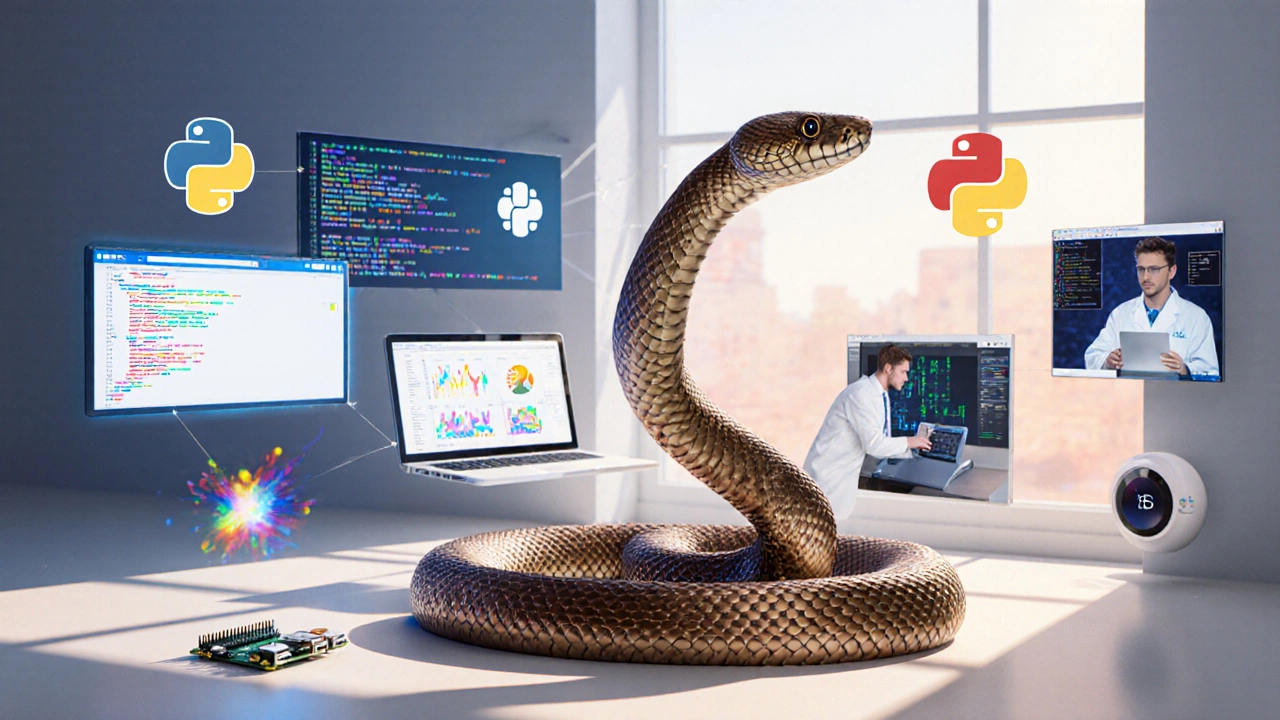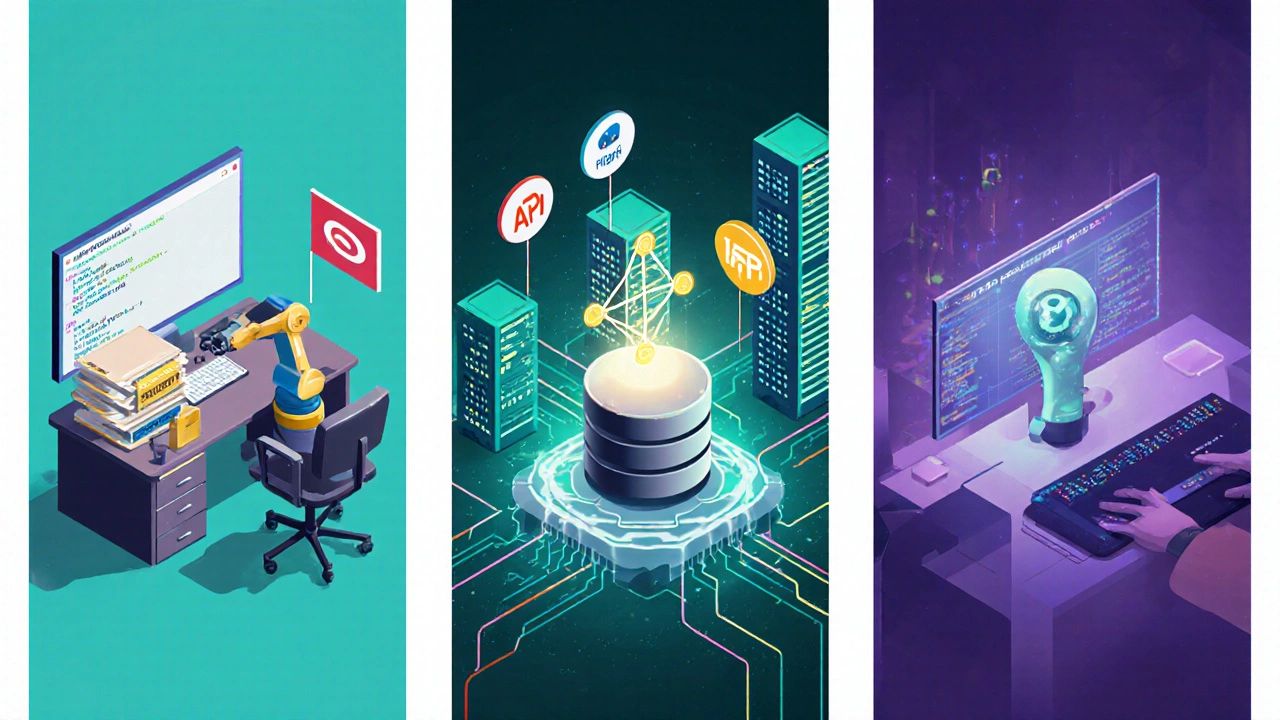
Python Use Case Explorer
Select a category below to learn about Python's applications in that domain:
Automation & Scripting
Automate repetitive tasks and streamline workflows
Web Development
Build dynamic websites and web applications
Data Science
Analyze and visualize complex datasets
Machine Learning
Develop AI models and intelligent systems
Scientific Computing
Perform advanced mathematical and scientific calculations
Game Development
Create interactive games and multimedia experiences
IoT & Embedded
Connect physical devices and embedded systems
Education
Teach programming concepts to beginners
Key Libraries:
Typical Projects:
Industry Example:
Ever wonder why Python is everywhere-from start‑ups building web apps to scientists crunching massive data sets? The answer lies in its flexibility, readable syntax, and a massive ecosystem of libraries. In this guide we’ll break down the most common ways developers and organisations put Python to work, give you concrete examples, and show which tools to reach for in each scenario.
Automation and Scripting: Speeding Up Routine Tasks
When you need to automate repetitive actions on a computer, Scripting with Python often becomes the go‑to solution. A short script can rename thousands of files, pull data from a website, or generate reports without manual clicks. The standard library includes os and shutil for file operations, while pyautogui can simulate keyboard and mouse actions. Companies like Spotify use Python scripts to manage their deployment pipelines, cutting hours of manual work into minutes.
Web Development: Building Dynamic Sites Quickly
Web Development with Python shines thanks to frameworks such as Django and Flask. Django offers a "batteries‑included" approach: authentication, admin panels, and ORM out of the box, which lets developers focus on business logic. Flask provides a lightweight core that you can extend with extensions like SQLAlchemy for database handling. Real‑world examples include Instagram, which started on Django, and Pinterest, which uses Flask for certain micro‑services. The typical stack includes HTML/CSS front‑end, a Python back‑end, and a PostgreSQL or MySQL database.
Data Science and Analytics: Turning Numbers Into Insight
Data scientists love Python for its Python uses in cleaning, visualising, and modelling data. Libraries like pandas make tabular data manipulation as easy as Excel formulas, while NumPy provides fast array operations written in C. Visualization is handled by Matplotlib, Seaborn, and interactive tools like Plotly. Companies such as Netflix analyse viewing habits with pandas pipelines, and banks detect fraud using Python‑based analytics.

Machine Learning and AI: Teaching Computers to Learn
When it comes to Machine Learning, Python dominates the landscape. The scikit‑learn library offers simple APIs for regression, classification, and clustering, while TensorFlow and PyTorch provide deep‑learning capabilities for image‑recognition, natural‑language processing, and reinforcement learning. For example, OpenAI’s GPT models are trained using PyTorch, and autonomous‑vehicle firms use TensorFlow to process sensor data in real time. Python’s ecosystem also includes Keras for rapid prototyping and XGBoost for high‑performance gradient boosting.
Scientific Computing and Research: Powering Academia
Researchers across physics, biology, and chemistry rely on Python for heavy numerical work. The SciPy library builds on NumPy to offer optimization, integration, and signal‑processing functions. Domain‑specific packages like Biopython (bio‑informatics) and Astropy (astronomy) let scientists write reproducible scripts that replace legacy Fortran code. A notable case: the Large Hadron Collider at CERN uses Python for data‑quality monitoring and visualization.
Game Development and Multimedia: Crafting Interactive Experiences
Although not as mainstream as C++ for AAA titles, Python powers many indie games and prototyping pipelines. The Pygame library provides 2D graphics, sound, and input handling, enabling developers to build games like "Frets on Fire" entirely in Python. For 3D work, Blender’s scripting API uses Python to automate modelling, rigging, and rendering tasks. Studios also embed Python for tools development-think asset pipelines that convert textures or generate level data on the fly.
Internet of Things (IoT) and Embedded Systems: Connecting the Physical World
Python isn’t limited to desktop or cloud; it runs on tiny devices too. MicroPython and CircuitPython are trimmed‑down versions that fit on microcontrollers such as the ESP8266, Raspberry Pi Pico, and Arduino boards. Developers write scripts to read sensor data, control LEDs, or communicate over MQTT with a few lines of code. Smart‑home projects-like a RaspberryPi‑based thermostat-often start with a Python script that talks to Home Assistant, demonstrating how Python bridges hardware and cloud services.
Education and Learning: Teaching the Next Generation of Coders
Because of its readable syntax, Python is the preferred language in schools and online courses. Platforms like Coursera, edX, and Khan Academy structure their introductory programming modules around Python basics-variables, loops, functions-before moving to data analysis or AI labs. In Australia, the Victorian Curriculum lists Python as the primary language for Year10 computing, reinforcing its role in preparing students for the modern workforce.
Quick Comparison of Python Use Cases
| Domain | Key Libraries | Typical Projects | Industry Example |
|---|---|---|---|
| Automation & Scripting | os, shutil, pyautogui | File batch processing, web scraping | Spotify deployment scripts |
| Web Development | Django, Flask, SQLAlchemy | Content sites, REST APIs | Instagram (Django) |
| Data Science | pandas, NumPy, Matplotlib | Data cleaning, dashboards | Netflix recommendation analysis |
| Machine Learning | scikit‑learn, TensorFlow, PyTorch | Image classification, chatbots | OpenAI GPT training (PyTorch) |
| Scientific Computing | SciPy, Biopython, Astropy | Signal processing, genome analysis | CERN data monitoring |
| Game Development | Pygame, Blender API | 2D indie games, asset pipelines | Frets on Fire (Pygame) |
| IoT & Embedded | MicroPython, CircuitPython | Sensor logging, smart‑home hubs | Raspberry Pi thermostat |
| Education | Jupyter, IDLE | Intro programming courses | Victorian Curriculum (Year 10) |
Getting Started: Your First Python Project
- Install the latest Python version (3.12 as of 2025) from python.org.
- Choose an IDE-VSCode with the Python extension works well for beginners.
- Set up a virtual environment:
python -m venv env && source env/bin/activate. - Pick a domain. For automation, install
pip install pyautogui. For data work, installpip install pandas matplotlib. - Write your script, run it with
python your_script.py, and iterate.
Even a simple "Hello, World!" program introduces you to Python’s clear syntax, and from there you can explore any of the domains covered above.
Frequently Asked Questions
Is Python suitable for mobile app development?
Python isn’t the primary language for native iOS or Android apps, but frameworks like Kivy and BeeWare let you build cross‑platform apps. For performance‑critical mobile features, developers usually write the core in Java/Kotlin or Swift and expose a Python layer for logic.
How does Python compare to JavaScript for web development?
JavaScript runs directly in browsers, making it essential for front‑end interactivity. Python handles the back‑end, managing data, authentication, and APIs. In a full‑stack project, you often pair Python (Django/Flask) with JavaScript frameworks like React for a complete solution.
Can I use Python for high‑performance computing?
Yes, when combined with libraries that delegate heavy lifting to compiled code. NumPy, SciPy, and Numba compile critical loops to C or machine code, achieving performance close to native languages. For truly massive workloads, Python often orchestrates jobs on clusters managed by Spark or Dask.
Is Python good for beginners with no coding background?
Absolutely. Its syntax reads like plain English, and the interactive REPL lets learners test ideas instantly. Many coding bootcamps and school curricula start with Python for this reason.
What are the most in‑demand Python skills for 2025?
Employers look for proficiency in data‑science stacks (pandas, scikit‑learn), web frameworks (Django, FastAPI), cloud deployment (Docker, Kubernetes), and AI libraries (PyTorch, TensorFlow). Familiarity with CI/CD pipelines and API design also boosts employability.
